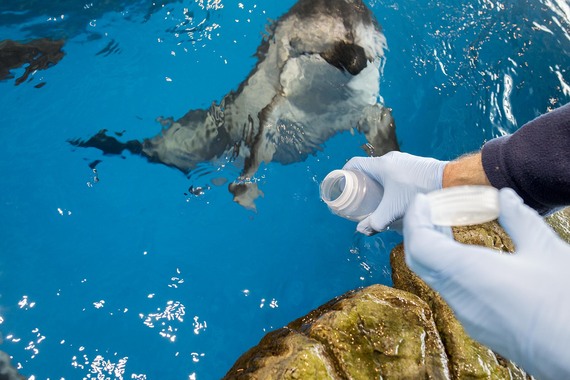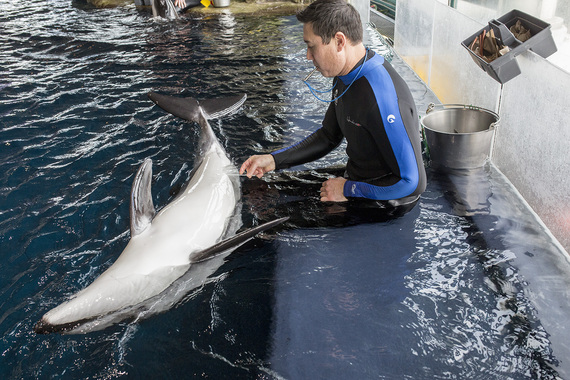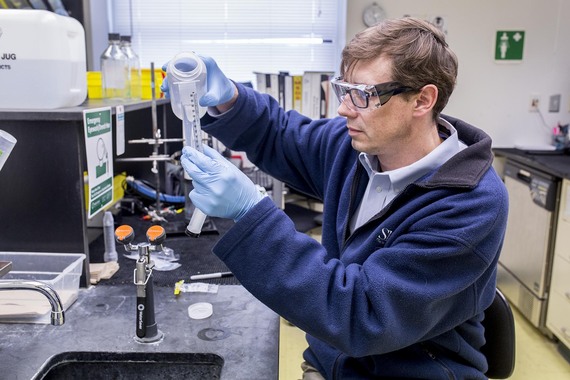"Must be something in the water... "
In fact, there are TONS of things in the water; millions and millions of things. It's no secret that most of the earth's surface is water - somewhere around 70% of it - so if you think about the distribution of living things on this planet it's no surprise that it's all about water.
Most life forms that live on land or in the air exist at a fairly narrow interface; right there at the surface. You don't find too many animals that dig that deep in the dirt or that fly that high in the air. If you take a look at the water you find a very different situation. Water is alive with all kinds of critters and they exist from the very surface to the deepest depths. When you consider this, it's pretty easy to realize that the vast majority of life as we know it on this planet--is in the water. And the majority of living things in the water are not visible to the naked eye. We all know and love sharks, whales and their friends in the oceans, but critical to them all are the microbes.
Microbes
These teeny tiny living creatures, or microbes, include the bacteria, viruses, fungi and prehistoric organisms known as archaea. They are responsible for 98% of the biochemical processes happening in the oceans, including producing over 50% of the oxygen released into the air we breathe. These little guys are the basis of life as we know it on earth and they are just now beginning to be understood. Until recently scientists were not even able to detect the presence of many of them.
Most microbes of medical importance were discovered and investigated by growing them on surfaces or in solutions that contains nutrients essential to their growth; germ-food, if you will. Today we know that many, likely most, aquatic microbes do not grow on traditional media and as a result were hidden from us. We didn't, and in many cases still don't, know what it is they need to "eat" to survive. Now, however, with the advent of modern molecular biology, we can detect the genomic material from all these critters. By isolating the nucleic acids (the DNA and RNA) in samples and decoding them we can begin to build a more complete picture of all the life forms that were in these samples- and we are finding astounding things.
One milliliter of seawater, which is one-thirtieth of an ounce, can contain 10 million individual viruses alone! And those viruses are living alongside millions of bacteria and other single celled organisms in communities we call microbiomes. When you multiply them all by the numbers of liters of water in the world and add everything up- the results are staggering; numbers so high they are hard to comprehend. And all these critters are doing things - important things. They cycle nutrients passing the raw products back and forth between each other like so many miniature recycling centers and factories. They fight and war each other, they eat each other, they cohabitate and support each other. They co-exist with each other and have done so successfully for millions upon millions of years. So too have all the big guys; the sharks and other fishes, the whales and dolphins, the jellies and otters, the whole aquatic community has evolved over these millions upon millions of years and figured out how to survive.
Questions and Answers
How do they do it? How do fish survive in a soup of living things waiting to recycle them? What factors influence which type of microbe is the most numerous? Why do populations of all critters increase and decrease over time? What things under the control of people influence the intricate balance that native systems strive for? How can we do a better job of taking care of aquarium earth?
To answer these and more questions like them Shedd Aquarium has embarked upon the Aquarium Microbiome Project. Modeled in part after similar projects looking at the environments that humans live in and the influence of microbes on human health and well-being, we are exploring the microscopic world in the hundreds of aquatic systems we manage. Aquariums are excellent places to do this work. We routinely measure many things in the environments we provide to ensure we are providing the very best conditions possible. Every day we are doing hundreds of tests of 'water quality'. We look at temperature, salt content, dissolved oxygen in the water, the level of wastes from the animals living in the water, the efficiency of the filter systems and so on. All of this information we can now compare to the communities of microbes living in the water at the same time. We can also control many of these factors; we can warm up or cool down the water, we can add CO2 and acidify it, we can add buffers and correct acidification, we can add nutrients for the microbes or remove things that act as nutrients like fertilizers.
In the end, this work will allow us to better understand how human activities influence water and the vast numbers of living things that call water home. We will be able to do a much better job of taking care of aquarium earth.
Bill Van Bonn, DVM, is Shedd Aquarium's vice president of animal health. With more than 25 years of clinical veterinary experience, Dr. Van Bonn strengthens the aquarium's established animal care and health expertise, overseeing its diverse aquatic medicine initiatives as well as furthering innovative veterinary science at Shedd. Dr. Van Bonn specializes in preventive medicine and enhanced clinical veterinary services for aquatic animals, with a focus on marine mammals. At Shedd, he focuses on providing top-quality care and applying his knowledge of animal health to conservation of their counterparts in the wild.


